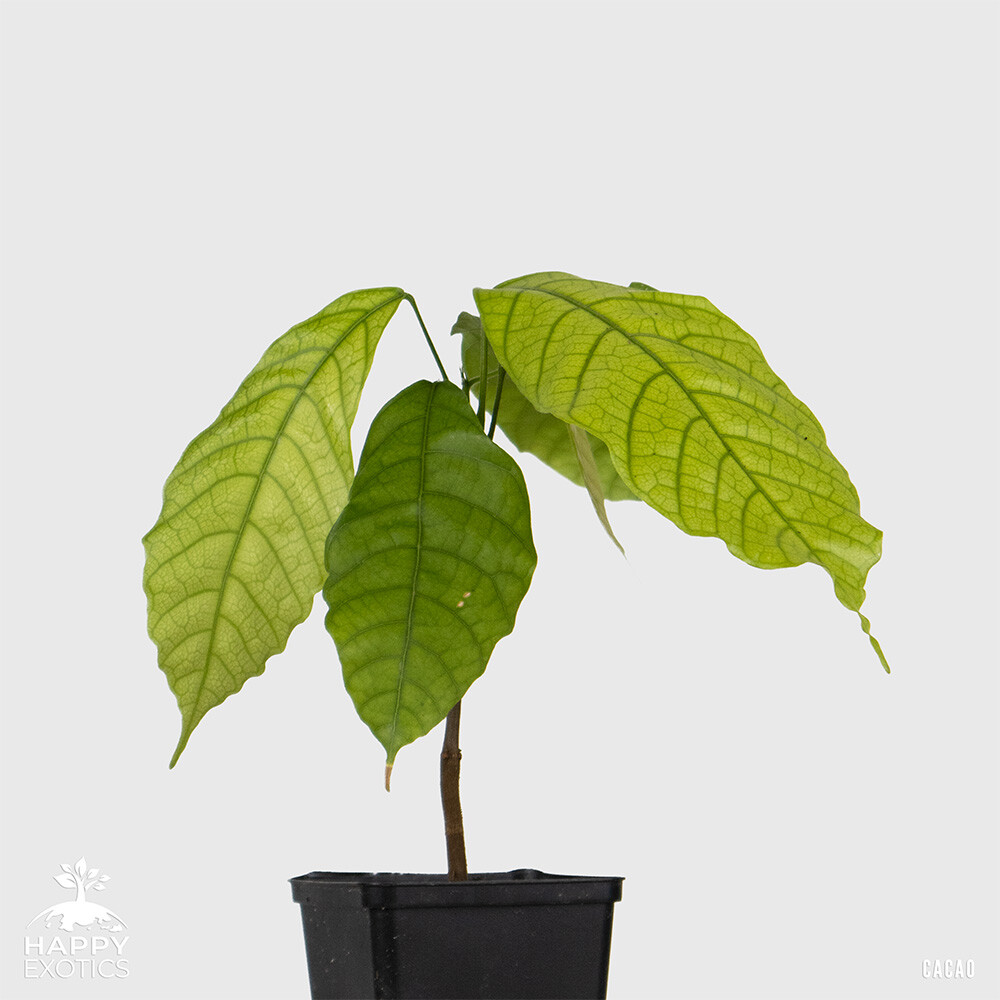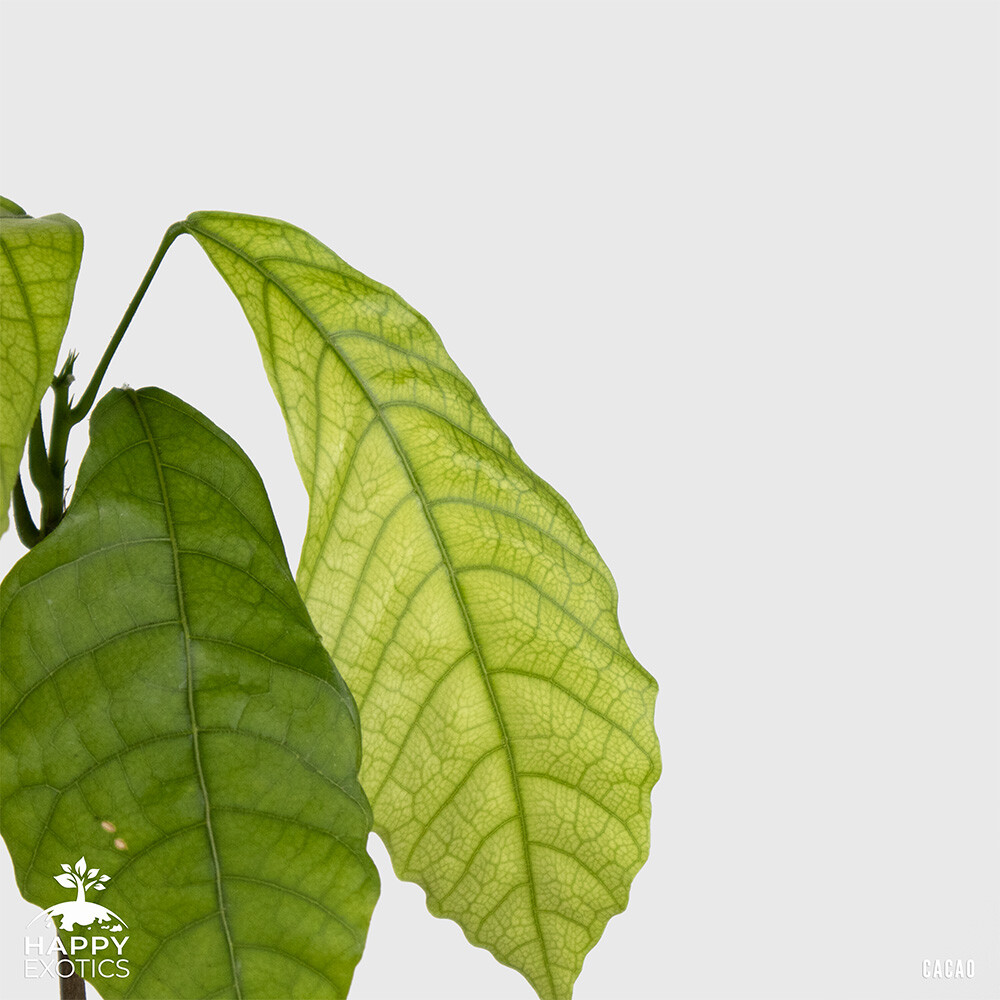1 happy Cacao tree | Theobroma Cacao | Forastero | Grown from seed | Rare in EU | Houseplant
€29.95
Out of stock
Email when stock available

Fast EU shipping

Grown in our own nursery
A cacao tree, scientifically known as Theobroma cacao, is a tropical evergreen tree native to the deep rainforests of Central and South America. It belongs to the family Malvaceae and is primarily cultivated for its fruit, which is used to produce chocolate.
Forastero cacao tree variety
This is a Forastero variety cacao tree. This variety is the most widely cultivated, accounting for about 80-90% of the world's cocoa production. It is known for its robust flavor profile, often described as bitter or earthy. Forastero trees are hardy and resistant to diseases, making them relatively easy to cultivate. However, the flavor is generally considered inferior to other varieties, which is why it's often used in bulk chocolate production.
Cacao tree fruit (pod)
 The cacao fruit, also known as a cacao pod, is the edible fruit of the cacao tree (Theobroma cacao). The pod is attached to the tree trunk or larger branches through a short stem known as the peduncle.
The cacao fruit, also known as a cacao pod, is the edible fruit of the cacao tree (Theobroma cacao). The pod is attached to the tree trunk or larger branches through a short stem known as the peduncle.
- Size and Shape: Cacao pods are relatively large and have a distinctive shape. They are elongated and typically measure around 15 to 25 centimeters (6 to 10 inches) in length. The size can vary depending on the variety and maturity of the pod.
- Color and Texture: The outer skin of a cacao pod has a thick, tough texture. When ripe, the color of the pod's exterior can range from yellow, orange to red. The surface of the pod can be smooth or slightly ribbed.
- Pulp: Inside the cacao pod, there is a sweet and tangy pulp that surrounds the cacao beans. The pulp is white and fleshy, and its flavor varies depending on the variety and ripeness of the fruit. It has a tropical fruity taste and is often consumed by animals and humans.
- Cacao Beans: The main reason for the popularity of cacao fruit is the beans (seeds) it contains. Embedded within the pulp of the pod, there are numerous cacao beans. These beans are arranged in rows or clusters and are usually covered with a whitish membrane. Cacao beans are oval-shaped, flattened, and about 1 to 3 centimeters (0.4 to 1.2 inches) in length.
- Harvesting and Processing: Cacao pods are harvested when they reach maturity. The process involves carefully cutting the pods from the tree using tools like machetes. Once harvested, the pods are opened, either by hand or using specialized tools, to extract the cacao beans and pulp. The beans undergo fermentation and drying processes to develop their characteristic flavor and aroma.
The cacao fruit is a vital part of the chocolate-making process. The beans extracted from the pods serve as the raw material for chocolate production, while the pulp can be consumed as a juicy snack or utilized in various culinary applications.

Additional information
| Weight | 0.4 kg |
|---|---|
| Dimensions | 32 × 10 × 10 cm |
Properties & Care
How to take care of a Cacao tree?
Taking care of a cacao tree involves providing it with the right growing conditions and proper maintenance. When taken care of properly, it is proven to produce cacao pods. Here are some essential tips for caring for a cacao tree grown in a pot:
- Suitable Growing Conditions: A chocolate plant needs a warm growing area that stays, for the most part, above 10-15°C, preferably with higher daytime temperatures and good quality light with some direct sunlight. This would be a large, south-facing window, a sunroom, greenhouse or conservatory. In most parts of Europe, Chocolate plants also benefit from being grown outside during the summer months in partial sunlight.
- Watering: Cacao trees require regular watering to keep the soil moist but not waterlogged. They prefer consistent moisture but can tolerate short dry periods.
- Fertilization: Cacao trees benefit from regular fertilization to maintain their health and productivity. Apply fertilizer in the recommended quantities and frequency according to the instructions on the product label. Typically, fertilizers are applied every 2 to 3 months.
- Pruning: Pruning helps maintain the shape of the tree, promotes airflow, and encourages better fruiting. Remove any dead, damaged, or diseased branches promptly. Prune the tree to your desired height and shape when in growing season.
- Humidity: If you notice leaves or yellow flowers turning brown and or dropping, this is an indication that the air’s moisture needs to be increased. If grown in a pot, use a humidity tray to increase humidity around the plant.
- Pollination: The tree should flower when 3-5 years old and about five feet (1.5 m.) tall. The cacao flowers on the same tree can’t pollinate/get pollinated by each other, but only by flowers from a different tree. So if you want your cacao tree to set fruit, you will need to have 2 trees. Hand-pollinate the flower in the early morning. Don’t panic if some of the resulting pods drop. It is natural for some pods to shrivel, leaving no more than two on each cushion.
FAQ
Propagation
Cacao trees are usually propagated through seeds, but can also be propagated by grafting or air layering.
Shipping & Returns
WARRANTY AND RETURNS
Despite the high quality of our products, it can occur that you receive a product that is not perfect. If that happens we’d like to provide you with a suitable solution as quickly as possible.
ALWAYS 2 YEARS WARRANTY
We are convinced of the quality of the products we offer. Therefore we always give 2 years guarantee on all your purchases.
14 DAY MONEY-BACK PERIOD
Curryelaftree.com operates a 14 day approval and inspection period for all online orders. This period starts when you have received the product. After 14 days the purchase agreement becomes final. During this period you should handle the product and packaging carefully, if reasonably possible. Try the product out to the extent necessary in order to decide whether you wish to keep it. The product can be vieuwd and reviewed, as you would do in a shop. When there is damage to the product or its packaging, this will be deducted from the return. When the product is used in this period, and now returned, the costs for use, such as cleaning or repair costs, will be deducted from the return. When you return a product within the 14 day money-back period, we are obliged to pay you the purchase price, including shipping and any debit or administration costs, back within 14 days from receiving your return.
DAMAGE UPON RECEIPT
All products are packaged safely and checked by Curryleaftree.com before shipping. If you nevertheless do receive a damaged product, please report the damage before returning the order.
RETURNS PROCEDURE
There are a number of reasons you may decide to return (a part of) your order. Read this information through carefully to avoid any misunderstandings and delays. If you wish to return a product, the method of shipment and the condition of the product must comply with our stated terms and conditions below.
Returns Form
For the return of a shipment contact us first. By filling in a form and sending it to us, you let us you know that you want to return your shipment. When we have received this form, we will start processing your return. You can always email us to discuss your return.
Return Shipment and Costs
The correct postal franking costs must always be paid for a return shipment. Packages not correctly franked or marked as returned subject to payment on delivery will not be accepted by us. Curryleaftree.com reimburses the postal costs after returning in case the return is a result of an mistake by Curryleaftree.com or when there is a defective product. If you are entitled to a refund of the shipping costs, we apply a maximum fee. You can also choose to bring the product back or exchange it at the Curryleaftree.com office. This is fast, easy and free of charge. The maximum fee for a return shipment is € 6,95 within the Netherlands, € 9,95 for Belgium and Germany, € 25.95 for the rest of Europe and € 29,00 for the rest of the world.
Return Address
Curryleaftree.com
Warranty and Returns
Tolweg 2W 3851 SK
Ermelo The Netherlands
Only logged in customers who have purchased this product may leave a review.



Reviews
There are no reviews yet.